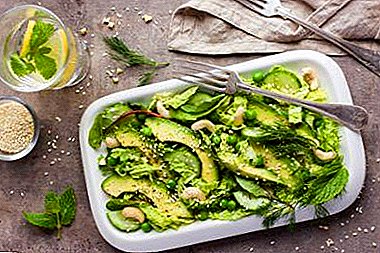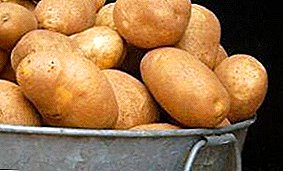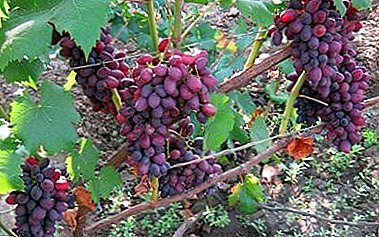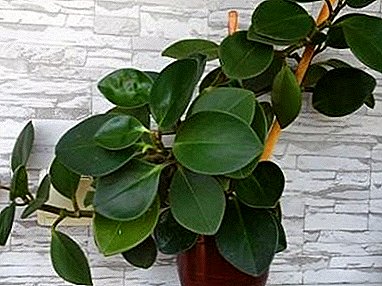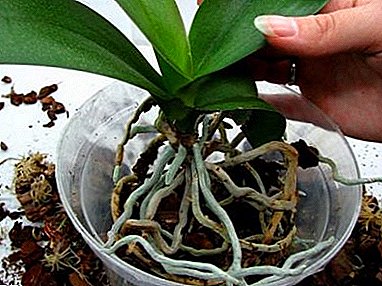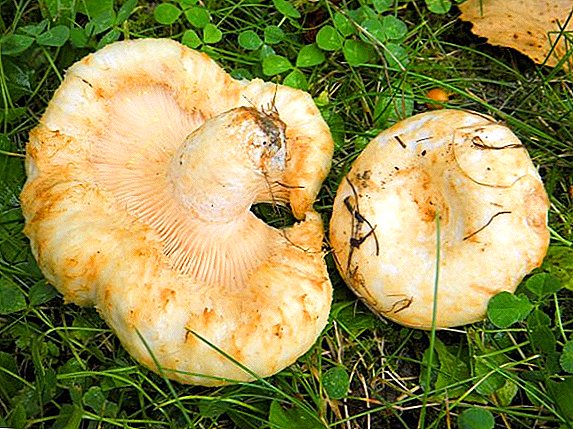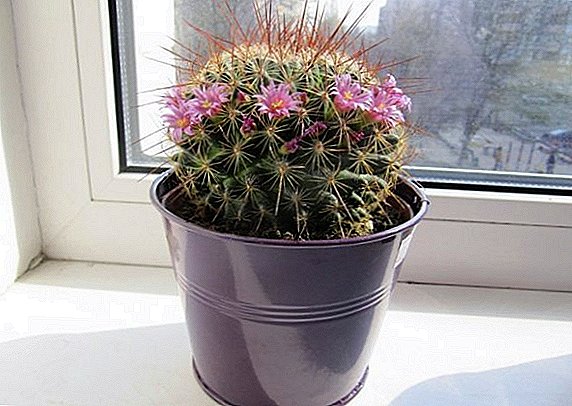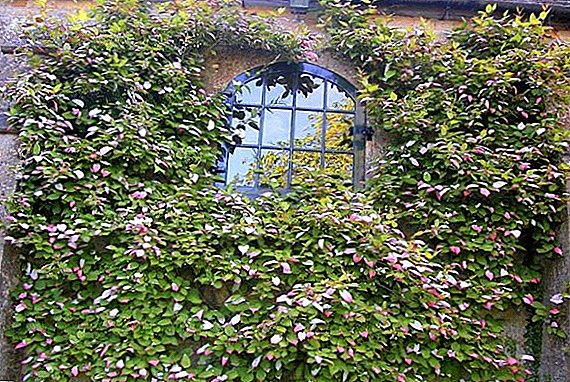 Actinidia Kolomikta - a plant that can be used not only as a decorative element for your garden, but also as a fruit and berry crop. Even Michurin himself noted the high quality of the fruits of this plant and foreshadowed the fact that it was very likely that the time would come when Actinidia would completely replace the grapes. In the first place, it owes such laudatory clothing to its high winter hardiness and good tolerance of our climate. In this article you can find the information you need about this plant, the principles of planting and caring for it.
Actinidia Kolomikta - a plant that can be used not only as a decorative element for your garden, but also as a fruit and berry crop. Even Michurin himself noted the high quality of the fruits of this plant and foreshadowed the fact that it was very likely that the time would come when Actinidia would completely replace the grapes. In the first place, it owes such laudatory clothing to its high winter hardiness and good tolerance of our climate. In this article you can find the information you need about this plant, the principles of planting and caring for it.
Description and winter hardiness
The type of this plant can best be described as a woody vine. The stem of the actinidia can be up to 5 cm in diameter; multiple brown shoots run away from it, smooth to the touch, with climbing or straight branches, capable of climbing up to a height of 15 meters. On young shoots there is a small amount of lentils. When confronted with an obstacle shoots twist it counterclockwise.
Did you know? The Greek name of this plant comes from the word "aktividio", which literally translates as "ray of light". Probably, this name is associated with the radial placement of the columns of the ovary.
The main feature of the leaves of this plant is their ever-changing color: At first they have a bronze tint, which eventually turns green, immediately before the flowering begins, the ends of the leaves become bright white in color, and at the end of this process they turn pink, crimson or red. Each leaf is located on the petioles 3-7 cm long, has the shape of an ellipse or egg, the leaf itself is rather thin, has a small amount of hairs along the veins, the bottom is smooth. 
The flowers have a pleasant, delicate aroma, most often of a white tint, actinomorphic, arranged on thin stalks, same-sex, drooping, sometimes bisexual specimens are found. Each flower includes five petals and as many sepals. A cup of flower after its drying remains with the fruits. This plant begins to bloom from the age of five, usually the period of active flowering occurs in June-July and lasts 20-25 days.
Actinidia is a plant that is not capable of self-pollination, therefore it is necessary to plant vines of different sexes next to each other in the area next to each other. To plants that also require a "pair" include willow, fig, laurel, poplar, sea buckthorn, sorrel, spinach.
Fruits - berries of a dark green shade, with a large number of longitudinal strips even more dark, than the main, color. They have a slightly elongated, elliptical shape, sometimes they can be round.  If you rip them in a ripe state, they will surprise you with their sweetness, softness of taste and spicy aroma. Inside each berry there is a fairly large number of small seeds (up to 90 pieces) of a dark brown shade. The period of fruiting begins with the age of nine.
If you rip them in a ripe state, they will surprise you with their sweetness, softness of taste and spicy aroma. Inside each berry there is a fairly large number of small seeds (up to 90 pieces) of a dark brown shade. The period of fruiting begins with the age of nine.
Did you know? Actinidia colomikta - plant long-liver. Under favorable environmental conditions, its life and active fruiting can reach up to 80-100 years.
Actinidia Kolomikta varieties
This plant can be cultivated by a gardener on a plot with two main objectives: as a fruit crop and as one of the elements of landscape design. Breeders brought a lot of different varieties of this woody liana, with a small list of the most popular ones you can see below.
- "Waffle". It was first received in Moscow VNIIR. The average yield per bush reaches 1 kilogram. Differs in the average period of ripening of fruits, each of which has a weight in the range of 3-3.5 g and an oval shape. Tastes of fruits are evaluated by tasters extremely positively;

- "Magpie". Gives medium sized bushes. The ripening period is medium. Differs extremely high winter hardiness. The average weight of the fruit is 2.5-3 g, the taste is very sweet, the berries have a specific actinidial smell. In the center of the berries is the core, which takes up to 1/3 of the total diameter of the berries;
- "Queen of the Garden". Bred in Moscow VNIIR. Differs in the early term of fruit ripening, is highly resistant to diseases and pests, winter hardiness is medium. The fruits have a cylindrical shape, compressed from the sides, olive shade, have a sweet-sour taste, the aroma has pineapple notes. The average weight of the fetus - 3.4 g
- "Gourmand". Maturing terms are average. The variety was included in the State Register in 1998. The fruits are cylindrical in shape, compressed laterally, the skin is greenish, very thin. It has very pleasant organoleptic properties: the smell of pineapple and a very sweet taste. Resistance to frosts and diseases - medium;

- "Large-fruited". Early ripening. The main feature is the extremely fast growth and early onset of fruiting. The average weight of the berries is 4.4 g. The fruits are cylindrical, olive-colored, with the aroma of kiwi and a sour-sweet taste. They tend to shatter when fully mature. Refers to the self-fertile;
- "Commander". Differs moderately pronounced winter hardiness and high resistance to pests and diseases. Refers to the male pollinating species, therefore, does not produce fruit. Flowers in clusters of 1-3 in each. There are no ovaries on flowers;
- "Adam". Another male pollinator form. It is characterized by moderate winter hardiness and an average indicator of resistance to diseases and pests. The flowers are large, white, 3-5 in each inflorescence. Flowers without ovaries, each has 5 petals.

Male and female actinidia: differences
Immediately it is necessary to say that almost all the varieties of this plant for normal fruiting and adequate flowering processes require the planting of actinidia next to each other of different sexes or plant branches with different sexes on one bush. Sometimes it happens that your vines stably bloom every year, but the berries in time and after it is not formed. Most likely, this phenomenon is due to the fact that actinidia of only one sex grow on your site.
VIDEO: HOW TO DISTINE THE ACTINIDES FEMALE FROM THE MEN Here's how to distinguish female plants of this species from male ones:
- on male plants, flowers are most often collected in inflorescences of 3 pieces each;
- in the center of male flowers there are no embryos of fruits;
- a large number of stamens can be found in a male flower;
- during the flowering period under the male plant you can find a lot of fallen flowers;
- flowers on female plants are often located one on a long stalk;
- in the center of the flowers of female plants is determined by a clear ovary of the future fetus;
- there are fewer stamens on the flowers of female plants, and they are much shorter than on male plants.
Important! When planting male plants, try to position them in relation to the female so that they are on the windward side. To improve pollination processes, you can also install a beehive with bees next to them.

How to choose seedlings when buying
Saplings of these plants are best purchased in specialized stores, nurseries or breeding centers, because by buying young plants in natural markets or with hands from sellers, you risk not buying the variety that was originally claimed, a variety with unsatisfactory organoleptic properties, and maybe even that instead of actinidia you will be sold a completely different plant.
First of all, when choosing a sapling, it is recommended to carefully examine its root for damages, both mechanically applied (by a human hand) and natural (various fungal lesions, dampened areas, frostbite, etc.). The root of a normal seedling of actinidia should in proportion to its overall size be proportional to the trunk (that is, be neither thinner nor thicker than it).
Learn how to grow actinidia in the garden and what plant varieties are suitable for the Leningrad region.
Next, you should pay attention to the condition of the trunk and leaves. If you see on them traces of obvious painful manifestations (white, gray or black spots, holes, bite, etc.), then you should not get such a seedling. In addition, it is not necessary to buy a sapling, which was clearly notched tip. For planting in the soil are suitable seedlings that have not yet reached the age of 4. 
Landing rules
In general, planting actinidia is no different from planting any other fruit and berry bush, but in connection with some of the biological features of its structure there are aspects that should be mentioned separately. Below we discuss in more detail such nuances.
Optimal timing
The best time for planting actinidia is spring, but planting in autumn is not excluded, it’s best 2-3 weeks before the first frosts. If you decide to plant actinidia in the autumn, it will be necessary to properly mulch the bushes with peat or rotted compost.
Where to plant on the site
This plant tolerates stagnant water rather poorly, so you should not plant it near gutters and groundwater accumulation sites, but at the same time, planting under a house wall or stone fence will help it to cope better with harsh winter conditions and increase its chances for successful transferring of this period. . 
Important! As already mentioned, actinidia is a climbing vine, so it will not be superfluous to prepare for it in advance a certain number of supports along which it will creep up. The amount and height of the supports directly determine how high its productivity will be.
This plant shows the best indicators of growth and development in the penumbra; this is primarily due to the fact that under natural conditions it mainly grows in sparse forests. Open spaces and constant exposure to direct sunlight affect this plant destructively.
Soils with an alkaline composition are very poorly suited for it, but at the same time it is fairly undemanding to the content of mineral and organic fertilizers in the soil and is well rooted and shows significant growth rates on soils with a poor nitrogen and phosphorus content. It is undesirable to plant this plant in soil with a heavy, clayey composition.
Stepwise landing process
 An approximate algorithm for planting is as follows:
An approximate algorithm for planting is as follows:
- First, it is necessary to prepare landing holes 50x50 cm in size. The distance between bushes should be 1.5–2 meters with the bush landing method, and not less than 50 centimeters with the vertical one.
- A drainage layer is laid on the bottom of each pit, it is desirable that it be a broken brick, shell rock or crushed stone.
- Then a layer of chernozem, 10-12 kg of humus, 150-200 g of superphosphate and several glasses of ash are introduced into each hole.
- A layer of fertilizer sprinkled with a thin layer of soil in order to protect young roots from possible chemical burns.
- After that, the seedling is placed in a hole in such a way that the root system is fully expanded in it, and gradually begin to sprinkle it with earth, compacting it.
- Next, plant a bush watered (1-1.5 buckets of water) and mulch the ground around it with peat, sand, or fallen leaves.
VIDEO: HOW TO GIVE ACTINIDIA CORRECTLY
Important! If you are transplanting actinidia from a pot with earth, then try not to shake off an earthen ball from it, as this can significantly harm the delicate root system of the plant.
How to care for actinidia
Caring for actinidia does not require any special skills from the gardener, but even in such a simple business there are some subtleties that would be worth your attention.
Watering
These bushes do not require particularly active watering, but in extremely dry and hot weather it is recommended to water them at least once a week at the rate of 1 bucket of water for each plant. With dry air and prolonged absence of rain, it is recommended to spray the plants with water from a spray bottle in the evening.
Familiarize yourself with beneficial properties and contraindications to actinidia.
This plant, as already mentioned, is extremely sensitive to excessive waterlogging, so it is recommended to check the soil for moisture before each planned irrigation. This can be done with a simple stick: pick up the soil in the tree circle to a depth of 3-5 centimeters and see if the plant needs additional hydration.
Mulching
To better preserve moisture, reduce the frequency of irrigation, and also to provide the plant with more comfortable conditions for wintering, it is recommended to mulch the tree trunk with peat, sand, or rotted foliage. Every few months, the layer of mulch needs to be updated, and once every six months, completely changed.
Mulching also helps to preserve more nutrients when feeding and to prevent the rapid evaporation of moisture from nutrients at excessively high temperatures.
Support
 Reliance is one of the very useful tools that will serve you especially well if you grow actinidia in order to produce fruits. The fact is that on the supports the vine has the possibility of almost unlimited growth upwards, respectively, the area of the likely appearance of ovaries on plants increases, which, in turn, leads to an increase in yield.
Reliance is one of the very useful tools that will serve you especially well if you grow actinidia in order to produce fruits. The fact is that on the supports the vine has the possibility of almost unlimited growth upwards, respectively, the area of the likely appearance of ovaries on plants increases, which, in turn, leads to an increase in yield.
For these lianas, supports with a height of 2-2.5 meters are best suited, which to increase the usable area is recommended to bend with a visor at a convenient angle for you at the height of human growth. Thus, the stalks of the plant, when they reach the highest point, will not stop growing, but will curl further along the support, but already at an angle to the vertical support.
Pruning
Pruning is a rather important aspect of caring for this plant, as it sets the future vector for the development of the entire liana and contributes to providing you with a rich and high-quality harvest. It should be noted that spring pruning for some reason (actinidia very actively "cries", because of which it may even die) is extremely undesirable.  It is best to prune during the period of active flowering or late autumn, after all the foliage has completely subsided. The first step is to remove all thin, dried and weak shoots. In addition, it is recommended to cut off all young shoots that did not have time to stiffen, since they can significantly reduce the quality of your liana's wintering.
It is best to prune during the period of active flowering or late autumn, after all the foliage has completely subsided. The first step is to remove all thin, dried and weak shoots. In addition, it is recommended to cut off all young shoots that did not have time to stiffen, since they can significantly reduce the quality of your liana's wintering.
Perennial frost-resistant vines also serve as excellent plants for creating hedges in the country. In addition to actinidia along the fence, you can plant girlish grapes, clematis or honeysuckle kaprifol.
Preparing for the winter
In addition to the already mentioned pruning and obligatory mulching of the stem, it is also recommended to remove the plant from the support and place it under a polyethylene or canvas bag. However, in the event that the winters in your region do not differ in special severity and are quite snowy, you can do without it.
VIDEO: COVERING ACTINIDIA IN WINTER So, we hope that this article has helped you find answers to many questions concerning the actinidia of colomicta. With love and respect, treat all the abodes of your garden, carefully monitor the condition of each plant, follow all the recommendations for caring for them, and then you and your family will surely receive a generous reward in the form of a bountiful harvest!
Cultivation Reviews




